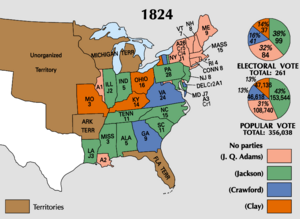權變選舉

四位候選人中沒有一人票數過半
在美國,權變選舉(或:臨時選舉;英語:Contingent election)是依據美國憲法第十二條修正案中提到的解決如果沒有總統候選人獲得過半選舉人票的情況下,由眾議院選總統,參議院選副總統程的程序。這種情況極為罕見,至今只發生過三次。觸發這一選舉程序的情形包括:
- 多名被選舉人競選,沒有單一被選舉人獲得50%以上的絕對多數選舉人票;
- 兩名被選舉人競選,雙方同時獲得50%的選舉人票。
美國憲法第十二條修正案中相關條文如下:
...The person having the greatest number of votes for President, shall be the President, if such number be a majority of the whole number of Electors appointed; and if no person have such majority, then from the persons having the highest numbers not exceeding three on the list of those voted for as President, the House of Representatives shall choose immediately, by ballot, the President. But in choosing the President, the votes shall be taken by states, the representation from each state having one vote; a quorum for this purpose shall consist of a member or members from two-thirds of the states, and a majority of all the states shall be necessary to a choice. And if the House of Representatives shall not choose a President whenever the right of choice shall devolve upon them, before the fourth day of March next following, then the Vice-President shall act as President, as in the case of the death or other constitutional disability of the President...
譯文如下:
詞源
[編輯]「權變投票制」(臨時投票)這一詞,在當前中文圈尚無進行分類無學術譯名。[3]
選舉機制
[編輯]在美國總統選舉中,如果沒有任何一位總統候選人在選舉人團中獲得絕對多數選票的情況下,根據憲法第二十條、第十二條修正案中相關規定,眾議院將通過權變選舉選出總統——每州一票,需要超過2/3的州代表出席,獲得超過總州數一半選票(美國現在有50個州,獲勝需要贏得至少26張選票)的人當選總統。合眾國的首都哥倫比亞特區因為不是州,所以不參與投票。
副總統由參議院投票決定,每個參議員有一票,獲得參議員總數的一半(美國現在有100名參議員,獲勝需要獲得至少51張選票,如果出現兩名候選人各的50張選票的情況,則現任副總統是否可以投出決定性的一票,尚有爭議)。
權變選舉的程序首先在美國憲法第1款條第2-6節中確立,然後於1804年各州批准後由第12條修正案修改。權變選舉極為罕見:美國歷史上僅發生過3次:1800年,托馬斯·傑斐遜由於建國早期在選舉程序的立法上有缺陷,導致他在該次選舉中一度與自己的副總統候選人阿龍·伯爾競爭。1824年,選舉人團的出現使四名候選人選票分裂,安德魯·傑克遜在權變選舉中輸給了約翰·昆西·亞當斯,儘管傑克遜贏得較多普選票也贏得較多選舉人票但仍落選。1836年,來自弗吉尼亞的24位不忠實選舉人雖支持了馬丁·范·布倫,卻拒絕投票支持副總統候選人理查德·門特·約翰遜,迫使參議院進行權變選舉選出副總統;在第一輪選舉中,參議院最終投票支持理查德·約翰遜為副總統。
參考文獻
[編輯]- ^ 任東來; 陳偉; 白雪峰; Charles J. McClain; Laurene Wu McClain. 美国宪政历程:影响美国的25个司法大案. 中國法制出版社. 2004年1月: 573. ISBN 7-80182-138-6.
- ^ 李道揆. 美国政府和政治(下册). 商務印書館. 1999: 775–799.
- ^ 排序复选制. Wikipedia. [2020-02-29]. (原始內容存檔於2021-03-19).
